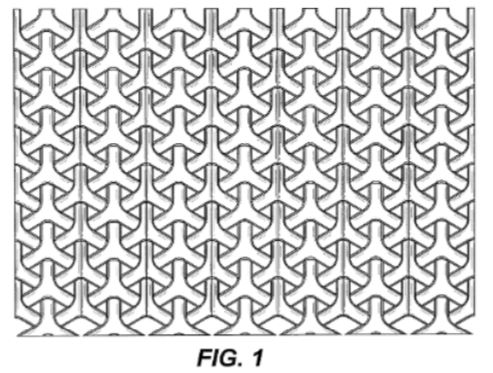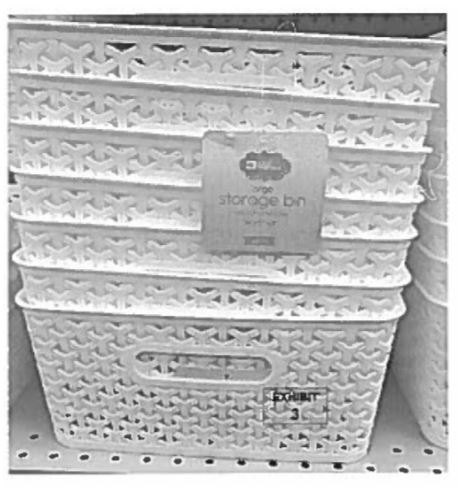LawFlash
Federal Circuit Limits Scope of Design Patent to Specific Article of Manufacture
September 20, 2019The Federal Circuit’s recent decision to dismiss a claim for design patent infringement raises the importance of the specification in design patents.
The US Court of Appeals for the Federal Circuit recently decided an appeal in Curver Luxembourg, Sarl, v. Home Expressions, Inc.,[1] finding that the claim language specifying a particular article of manufacture limited the scope of the design patent. In particular, the Federal Circuit held that the words used in the specification can limit the scope of a design patent when the only disclosure of an article of manufacture in the application are the words of the claim.
The asserted design patent, US Patent No. D677,946 (the D’946 Patent) is titled “Pattern for a Chair” and claims an “ornamental design for a pattern for a chair, as shown and described.” The drawings include a portion of a repeating overlapping “Y” pattern.

Figure 1 of the D’946 Patent
In addition to the claim language, the phrase “Pattern for a Chair” is also stated in the title and the description of the figures. When the D’946 Patent was originally filed, it was titled “Furniture (Part of-),” and the original claim recited “a design for a furniture part,” but the figures only illustrated a square section of the design as shown above and omitted the remainder of the furniture. The term “chair” was amended during prosecution to overcome an objection by the examiner to the specification. The examiner stated that under MPEP § 1503 (I) and 37 CFR § 1.153, the title must designate a “particular article” for the design, and that the title’s and specification’s use of “Part of” were too vague. The examiner suggested that the title be amended to “Pattern for a Chair” throughout the specification. Based on the examiner’s suggestions, the title, claim, and description of the figures were amended without any further discussion, and the application proceeded to allowance.
The assignee of the D’946 Patent, Curver Luxembourg (Curver) sued Home Expressions Inc. (Home Expressions) for patent infringement in the district court, alleging that Home Expressions made and sold baskets incorporating Curver’s claimed overlapping “Y” design pattern.

Home Expressions’s baskets
Home Expressions moved to dismiss under FRCP 12(b)(6) stating that Home Expressions’s accused baskets cannot infringe the D’946 Patent since the D’946 Patent is limited to chairs only. The district court conducted a two-step analysis to determine if Curver’s complaint stated a plausible infringement claim. First, the district court construed the scope of the D’946 Patent to be limited to a chair based on the text of the D’946 Patent. Second, the district court compared the accused product to the claimed design based on the “ordinary observer test”[2] to determine whether Home Expressions’s baskets infringed the D’946 Patent. The district court determined that an ordinary observer would not purchase Home Expressions’s basket with the “Y” design believing that they were purchasing a chair with the “Y” design. Accordingly, the district court agreed with Home Expressions and granted their motion to dismiss, which Curver appealed to the Federal Circuit.
On appeal, Curver argued that the district court improperly relied on claim langue to limit the design patent to a chair, rather than focusing on the figures, which are devoid of any illustration of a chair. The Federal Circuit interpreted Curver’s argument to be a request for a patent on a surface ornamentation per se, which would improperly allow Curver’s patent to cover every possible article of manufacture having the claimed surface ornamentation. The Federal Circuit and Curver both acknowledged that current patent law has never sanctioned granting a design patent for surface ornamentation per se to cover all possible articles.[3]
The Federal Circuit stated that courts have traditionally focused on the figures illustrated in the patent to define the scope of a design patent.[4] However, the Federal Circuit was asked to address whether claim language specifying an article of manufacture can limit the scope of a design patent when the article of manufacture is not illustrated in the figures. In addressing this atypical situation, the Federal Circuit stated that in obtaining a design patent, the design must be tied to a particular article based on not just the illustrations, but also the claim language.[5] The Federal Circuit noted that not only does relying on the article of manufacture disclosed in the claim language provide proper notice to the public regarding what is and what is not protected, but it also imposes practicable limits on prior art searching.[6] The Federal Circuit reasoned that limiting the scope of a design patent based on the article mentioned in the claim language is appropriate as inventors seeking broader protection may do so via copyright protection.[7]
To further support its position, Curver argued that the district court improperly applied prosecution history estoppel to limit the scope of the D’946 Patent to a chair by focusing on the text of the patent instead of only the figures. The Federal Circuit stated it is appropriate to rely on the text of a design patent and that in amending the design patent application, Curver did not dispute the validity of the examiner’s objection, and that the amendment was necessary to secure the patent. Therefore, the Federal Circuit held that the scope of the D’946 Patent is limited by the amendments.
Curver additionally argued that the district court misapplied the test for determining design patent infringement. Relying on In re Glavas, Curver stated that Glavas suggests that a design patent can be anticipated by prior art articles that are unrelated to the article shown in the design patent, i.e., a basket having a design can anticipate a chair claiming the same design.[8] Curver extended this rationale to infringement since, historically, courts have used the same test to determine anticipation and infringement. [9]
The Federal Circuit disagreed with Curver’s approach stating that the statements regarding anticipation in Glavas were nonbinding dictum and that Curver was misapplying Glavas. More importantly, the Federal Circuit stated that the sole test for determining infringement of design patents is the “ordinary observer test,” and to the extent that Glavas is in conflict with this test, that dictum must give way to the established ”ordinary observer test.”[10] Accordingly, the Federal Circuit asserted that under the “ordinary observer test,” no “ordinary observer” could be deceived into purchasing Home Expressions’s baskets believing they were the same as the patterned chairs claimed in the D’946 Patent.
It is interesting to note that the US Patent and Trademark Office (USPTO) rules rely on Glavas in stating that “[a]nticipation does not require that the claimed design and the prior art be from analogous arts.” [11] Accordingly, there exists a conflict between the holding of this decision and the current USPTO rules. If the courts continue to use the same test for design patent infringement as they do for anticipation, this decision may provide ammunition for design patent applicants to push back against prior art rejections that include nonanalogous art.
Practice Pointers
In view of this decision, design patent applicants will have to balance pursuing broad claim coverage with being specific enough to avoid an objection by the examiner for being too vague or not directed to a particular article. Applicants may want to take care in describing the design, particularly partial designs, and consider if multiple design patent applications should be filed to cover various articles. Further, applicants may want to ensure that the original application as filed includes sufficient support for any potential amendments or continuations directed to different articles of manufacture. In addition, due to the risk of prosecution history estoppel, applicants now have much more incentive to traverse examiner objections to the claim language and title during prosecution.
For design patents that have already issued, patentees may want to consider filing broadening Reissue applications to proactively broaden out the claim language.
Finally, industrial design owners may also consider layering on copyright protection, particularly for designs that may be applied to a variety of different articles, to fully protect their designs.
Contacts
If you have any questions or would like more information on the issues discussed in this LawFlash, please contact the authors, John L. Hemmer, Kenneth J. Davis, or Vishal J. Parikh in our Philadelphia office, or any of the following lawyers:
Boston
Joshua M. Dalton
Chicago
Scott D. Sherwin
Jason C. White
Houston
C. Erik Hawes
Philadelphia
Louis W. Beardell, Jr.
San Francisco
Brent A. Hawkins
Brett A. Lovejoy, Ph.D.
Carla B. Oakley
Silicon Valley
Dion M. Bregman
Douglas J. Crisman
Andrew Gray IV
Michael J. Lyons
Washington, DC
Eric S. Namrow
Collin W. Park
[1] No. 2018-2214 (Fed. Cir. September 12, 2019)
[2] Under the “ordinary observer test,” an accused product infringes a design patent if in the eye of an ordinary observer the two designs are substantially the same such that the resemblance is enough to deceive an observer, thereby inducing them to purchase one supposing it to be the other. Gorham Co. v. White, 81 U.S. 511, 528 (1871); See also Egyptian Goddess, Inc. v. Swisa, Inc., 543 F.3d 665, 678 (Fed. Cir. 2008) (holding that the “ordinary observer test” is the sole test in analyzing design patent infringement.)
[3] Curver Luxembourg, Sarl, v. Home Expressions Inc., No. 2018-2214, slip op. at 7 (Fed. Cir. September 12, 2019)
[4] See Pac. Coast Marine Windshields Ltd. V. Malibu Boats, LLC, 779 F.3d 694, 702 (Fed. Cir. 2014)
[5] Curver Luxembourg, No. 2018-2214, slip op. at 8-10
[6] See Curver Luxembourg, No. 2018-2214, slip op. at fn. 3 (citing Star Athletica, L.L.C. v. Varsity Brands, Inc., 137 S. Ct. 1002, 1010 (2017) )
[7] See id.
[8] In re Glavas, 230 F.2d 447, 450 (CCPA 1956)
[9] See, e.g., Peters v. Active Mfg. Co., 129 U.S. 530, 537 (1889) (“That which infringes, if later, would anticipate if earlier.”); Int’l Seaway Trading Corp. v. Walgreens Corp., 589 F.3d 1233, 1239 (Fed. Cir. 2009) (“[I]t has been well established for over a century that the same test must be used for both infringement and anticipation . . . .”).
[10] Curver Luxembourg, No. 2018-2214, slip op. at 13-14
[11] See MPEP § 1504.02 (citing In re Glavas, 230 F.2d 447, 450, (CCPA 1956) (“It is true that the use to which an article is to be put has no bearing on its patentability as a design and that if the prior art discloses any article of substantially the same appearance as that of an applicant, it is immaterial what the use of such article is. Accordingly, so far as anticipation by a single prior art disclosure is concerned, there can be no question as to nonanalogous art in design cases.”))